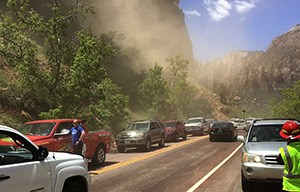The Federal Lands Transportation Program (FLTP) improves multi-modal access to and within national parks by providing funding, in partnership with the Federal Highway Administration's Federal Lands Highway office (FLH), for transportation facilities owned and maintained by the National Park Service.
The FLTP mission is to preserve and protect park resources, while providing safe and enjoyable access to and within the national parks, using sustainable, appropriate, and integrated transportation solutions. We provide and maintain high quality transportation infrastructure and services, deliver safe, efficient, effective, and environmentally-friendly transportation infrastructure projects and services, and serve as a leader and innovator in transportation.
The FLTP provides funding for projects (including some multimodal projects), long range planning, and the development of asset management systems that maintain and improve the condition of NPS transportation systems. Learn more below!
Multi-Year Program of Projects
The Federal Lands Transportation Program brings expertise together from the Federal Highway Administration (FHWA) and the NPS Washington Area Support Office, the Denver Service Center, the seven regional offices, and individual park units to deliver the program of projects. The program of projects is developed through the transportation planning process resulting in a multi-year plan for road, bridge, and multimodal projects. Many of these projects, if regionally significant, are included in a Transportation Improvement Program (TIP) that FLH approves and submits to the states to be included in their State Transportation Improvement Programs (STIP). Most of the FLTP funds are used for “transportation asset management” – that is, to pay for the work required to keep existing NPS roads, bridges and tunnels in good condition.
Multimodal Strategy and Innovation Program
The Multimodal Strategy and Innovation Program (MS&I) coordinates policies, projects and activities related to transportation planning, partnering, and implementation of multimodal systems within and to NPS units. MS&I also develops strategies and recommendations for Servicewide application on issues crossing agency and state/federal lines and jurisdictions. Since 1999, multimodal projects, such as transit services, also have been supported with FLTP funds.Management Systems
The NPS Transportation Program uses four management systems as important decision support tools. These systems provide parks and regions with basic condition, performance, and cost information to help set priorities when setting budgets for park unit proposals. The four management systems are being jointly developed by the National Park Service and the Federal Lands Highway Office. The FLTP funds the data collection for these management systems.

Pavement Management System
The Pavement Management System helps identify potential road resurfacing, rehabilitation, and reconstruction projects, and assists transportation managers in in making informed decisions when selecting projects. The pavement management system uses data from the Road Inventory Program (RIP), which includes condition and inventory information on park unit roads.

Bridge Management System
The Bridge Management System is intended to improve decision making about the type and priority of bridge investments, based on inspection data now collected as part of the Bridge Inspection Program (BIP). A fully developed bridge management system will provide a basis for recommendations for optimal expenditures of funds and will identify critical needs on a system-wide basis. The information collected also will provide input for the preparation of rehabilitation plans and specifications, and for construction support.

Safety Management System
Growing traffic volumes, increased vehicle sizes, and the inevitable clashes between vehicles or wildlife and vehicles are just a few of the factors contributing to increased concerns for visitor, staff, and wildlife safety on park roads. The NPS transportation Safety Management System is currently under development. When fully operational, NPS will use the analysis of crash data, along with: geospatial, design, and road condition data, to identify the most appropriate engineering or behavioral intervention strategies

Congestion Management System
The Congestion Management System will provide a method to identify priority congestion-related projects affecting NPS and other federal land management agencies. The Congestion Management Toolkit provides technical assistance for those with congestion management problems. Multiple tools may be needed to resolve congestions issues.
Long Range Transportation Planning Program
The Long Range Transportation Planning Program provides program management, policy, tools, processes, and guidance to coordinate a comprehensive approach to transportation planning within the NPS. Transportation planning addresses multimodal transportation needs, resource and environmental stewardship, visitor experience, and asset management to ensure that transportation systems provide efficient, enjoyable, and safe access in harmony with park resources and experiences.
The benefits of long range transportation planning outcomes include the following:
-
Unimpaired access to park destinations, facilities and experiences;
-
Improved transportation-related visitor experiences;
-
Improved safety and reduced accidents, injuries, and fatalities;
-
Reduced congestion at entrances, on roads, and in parking lots;
-
Reduced or eliminated impacts to natural and cultural resources;
-
Improved operational effectiveness of transportation investments;
-
Coordinated alignment of capital, operations, and maintenance funding toward high-priority transportation investments;
-
Incorporation of current legislative actions, executive orders, and policies.
For the National Park Service, Long Range Transportation Plans coordinate transportation investments over a 20-year time horizon. This and other strategic plans ensure alignment with our Federal Highway Administration, state, metropolitan, and local government partners.
Last updated: March 5, 2025
